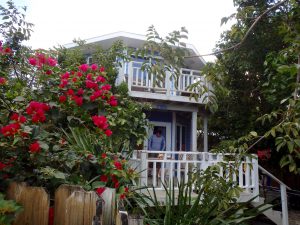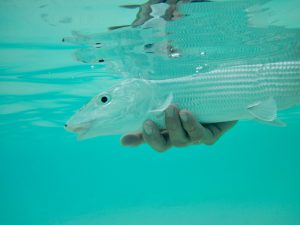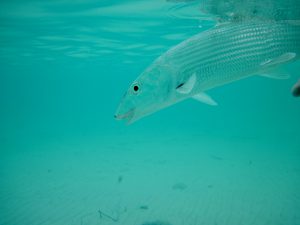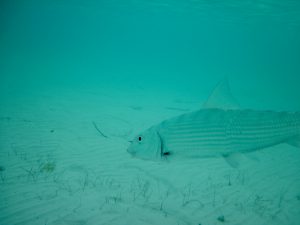
Just returned from the midwinter Bahamas wade fishing trip with my friend Captain Baz. Our destination is a band of coral islands at the edge of the horizon. We get there by flying out of Ft. Lauderdale but have to land somewhere in the Bahamas to clear customs and immigration and off we fly again. Where we are headed there are no fly fishing guides and no other anglers. This is a self-guided trip and it is not easy.

Bahamian islands – gorgeous colors
We drive down to south Florida, about 10 hours drive with short pit stops. Overnight in a hotel and next morning we fly out into the archipelago and settle in to our little fishing nest. We rent a small cottage and full meal service and a small boat (13´), which can be upgraded (to a 17´boat) at a reasonable charge. A marina and a bar are on site and it being windy was full of boaters waiting for the wind to subside. The atmosphere is laid-back, people are friendly and we are on island time.

Our cottage

The resident nurse shark

The local scenery
On arrival at noon all the bigger boats were already gone and we only had available a thirteen foot long skiff. A 13 ´skiff for one grown male and another a bit overgrown in the Atlantic is not ideal. The wind was blowing from the east with occasional whitecaps. Our target for this day was down wind of us so we sallied fort downwind in excellent spirits and found our flat. The wind was supposed to die down anyway.

The thirteen feet 30 HP skiff
Bonefish will come up on flats to feed when the tide is rising and vice versa will leave on falling water. They are maddeningly hard to spot and years of experience are needed to see those fish. There needs to be a sun otherwise you will not spot them at all but they cannot hide their shadows but are working on it. We have to figure out the likely spots where they will come on to the flat and likely leave by the same place. When on these flats they can be found in very shallow water and go into the Mangroves and disappear there in that thicket. So it can be difficult to find these fish. When spotted they are very skittish and the fly has to be placed in front of their traveling line. Thus lots of moving parts and much to go wrong and it does. Fly has to land softly otherwise you might spook them. In short very difficult fish.

Bonefish two feet away

Bonefish noir version

The tide is up on the flat

A Mangrove outpost on the flat

Flats and Mangroves
The first day Captain Baz caught a good size Bonefish on a brand new high-end rod. It is always a good omen that a new rod catches fish. Now if you look at the picture of the Mr. Bone you see that dapper little pencil mustache he is sporting. He looks a bit French to me or maybe Belgian – there it is Monsieur Hercule Poirot? Baz’s fish spotting vision is legendary and I rely on his spotting the fish. It is like hunting with a pointer and sure enough when I see him bent a bit and his butt sticking out I know he has a scent of a fish. Then he gives the coordinates for instance 60 feet ten o’clock from him and I triangulate and it works out pretty well. I am starting to spot those fish but nowhere near where I need to be.

Bonefish with pencil mustache

Baz with a nice Bonefish

Bonefish being released

A released Bonefish

A released Bonefish
Now time has come to return to the marina but the wind has picked up and the waves are now 2′ high. Our small dinghy is not built for such waves and underpowered (30 hps). Baz sails the boat into the waves and I sit on the center thwart* clutching the rods watching the waves. You see where this is going? A wave throws the bow of the boat up and then it comes down obeying Newton’s law. I on the other hand am airborne flying up and back having torn the thwart off and crash down on my back in the boat in front of Baz a bit later. He managed to pull his feet from boat zero. Landed flat on my back and my first question was understandably “Did I break the rods”? Of course I broke Baz’s rod setting me up for a predictable “I sure am happy I got to break it in before you broke it” from Baz. Oh well that is why we carry backup rods on all trips.

The tide is up on the flat
Folks generally have no clue how we go about wading flats chasing Bonefish. This is how we do it. Wading boots are needed and I like to wear neoprene socks. On top of the boots we have a gravel guard to reduce the sand and grit that will invariably find its way into our socks and boots. The gravel guards just decrease it a lot. We don shorts and it is best to wear something that dries fast when we get out of the water.

Wading boots socks no gravel guards
Long sleeve shirt for sun protection and fingerless gloves and a buff is called for. We top it off with a cap where I like the underside to be black to reduce the glare. Polaroids are vital otherwise fish will not be spotted in time. For fly line management I recommend a stripping basket. I know it looks nerdy not dressy at all but by Jove it works. Then you can have ready line to cast and you are in better control. It is also nice to place the rod transversely in the basket when waiting and looking for fish.

Baz with a stripping basket
We like fast rods if we can load/bend them. If we cannot they are useless to us. My recommendation to anglers is to use a 7-9 weight rod and pick the one that is your fastest and the one you can load comfortably. Do not fall for the marketing craze that wants you to buy the latest fastest rod absolutely a miracle yada yada yada. While I am at it there is no need for a Bonefish rod or a Bass rod or any specific rod for a certain type of a fish. The fish do not know and do not care. You need a rod that can cast your fly reasonably well and can handle the targeted species that is all there is to it. The line to use is a floating line and there are many excellent to choose from. I favor lines that are true to their size meaning I do not want it half or a whole step heavier than the standards set. Now when my casting has improved that is just what suits me. If you are a fledgling caster and load your rod better by over lining that is just fine and no cosmic rules have been broken by doing that. We use twelve feet long leaders and this trip a #8 Gotcha carried the day.

Gotcha #8
If you are in a situation where the leader does not turn over shorten it. We cast the line straight and lay out the leader straight (stiffer leader is better than a soft one for that). Then it is a good rule to strip once to get all slack out of the system and then let the fly sink to the bottom. Then you play with the strips and retrieve. All the usual casts and deliveries need to be mastered but there is one that Baz is a wizard at and actually his loops are sharpest when he uses that cast. When he has a fish to the right of him and feet set 90 degrees he does not turn his body he just sends the line out by this sidearm backhanded cast.
https://www.youtube.com/watch?v=E5NLo7nTwnw
This type of fishing is physically difficult, to say the least. We did six – seven hours of this every day, wading looking and just being one with nature. However it does a lot of good in the psychic department of our bodies. When a big fish takes your fly and you feel its power and speed you realize the force of life. There is then the pulling and giving back and forth and I am reminded that I am also an animal of the same nature and I need to be humble and cognizant of that fact.
Now as we wade these flats the ocean is warm and no waders are necessary. Sometimes the bottom is firm and sometimes muddy and you think that this is it you are being sucked down. Sometimes you are wading in an area where there are lots of depressions with a 5” hole at the bottom. Needless to say your imagine all kinds of creatures living there and they are just waiting for you to make a mistake and then they will act. Vedius Pollio comes to mind and his pool of lampreys.
https://en.wikipedia.org/wiki/Vedius_Pollio
In the series on my colleague Dr. Lecter there is a scene like that. Then there is one in the deliciously decadent Borgias series (season3). This mucking around invariably leads to sand and grit accumulating in you shoes and socks. We ignore it just a part of the deal.

No need for pedicure
Now I have to cancel my monthly Pedicure as my feet are now scrubbed clean of corns from all that friction and sea water.
* Thwart is the board that runs between gunwales and is used to sit on. I could not use the word boat seat cause it was just too lame. In Icelandic the word is þófta and I am indebted to my linguistics adviser Professor Joe Mozur friend and neighbor for digging this beauty up.
- The tide is up on the flat
- A released Bonefish
- A released Bonefish
- Baz with Bonefish
- A Mangrove outpost on the flat
- Baz with Bonefish
- Jonas casting
- No need for pedicure
- The reward
- Baz with the local beer
- Flats and Mangroves
- A likely cut for ingress and egress
- Gotcha #8
- The thirteen feet 30 HP skiff
- The local scenery
- Bonefish noir version
- Bonefish two feet away
- Baz with a stripping basket
- Baz with a nice Bonefish
- The resident nurse shark
- Waiting for the sun to pop out
- Our cottage
- Bahamian islands – gorgeous colors
- Wading boots socks no gravel guards
- Bonefish being released
- Bonefish with pencil mustache



























